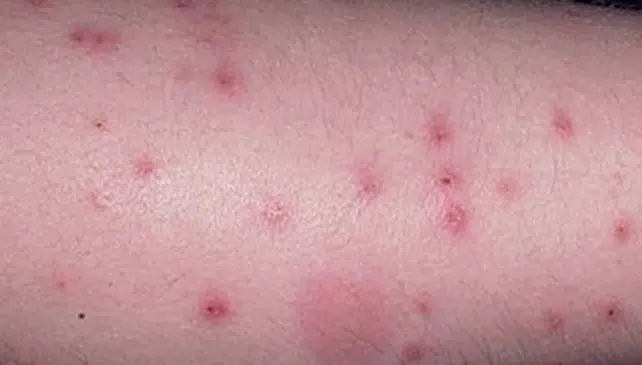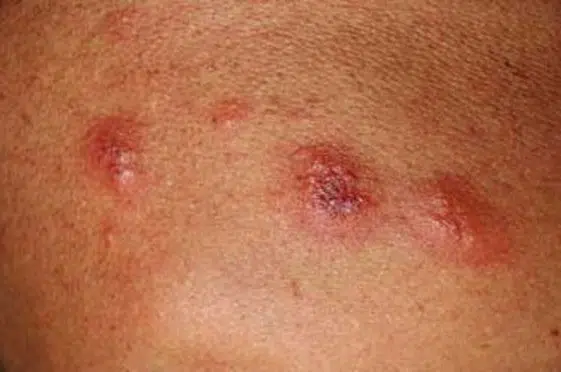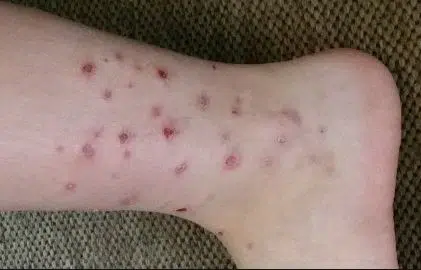Flea bites on humans can cause a lot of itch and discomfort. Dogs and cats are mostly the source of fleas that bite humans. Pictures of these insect bites show redness from inflammation as one of the symptoms. Here’s how to get rid of flea bites on humans with treatments and home remedies.
Fleas are small wingless insects that live on the blood of humans and animals. Although they prefer to live and feed on animals such as dogs and cats, they do consider humans as their source of food as well.
RECOMMENDED:
Flea bites on humans are usually caused by fleas on cats and dogs, and are usually very itchy and sometimes painful, appearing as small red bumps with a red halo around the bite. This reaction is actually caused by the flea’s saliva.
Flea Bites on Humans Pictures
What do flea bites on humans look like? It is important to distinguish between insect bites. Some people confuse flea bites for bed bug bites. It is also easy to think they are mosquito bites. Below and throughout the page are pictures of flea bites on humans. These will help you know how they look like.
Flea bites come in clusters or groups of about four and can even appear in a straight line. These bites are common on the ankles and legs, even around the waist, armpits, breasts, groin, and in the folds of elbows and knees.
If you need help figuring out if you were bitten or not and how to treat your bites, this post will help you identify them. You can see what the bites look like in the flea bite pictures section.
Are Flea Bites Dangerous, Harmful or Deadly?
Do flea bites cause disease? Are they dangerous or other risky side effects? Unfortunately, fleas don’t only target your pets where they can cause dermatitis in dogs and serious itching.
They can live indoors and bite you and your children. While too much itching and scratching following a flea bite can lead to infection, flea bites are also associated with other dangers. The dangers from flea bites are due to the disease-carrying nature of fleas.
The “black plague” is actually caused by a type of bacteria called Yersinia pestis. This bacteria is spread by fleas. It was reported to have killed 25 million people, making it dangerous and deadly.
There are a number of flea diseases that can be transmitted from fleas, but there is one particular among them that can be acquired from a flea bite. As of today, a number of cases of bubonic plague have been recorded in the United States.
Fleas are actually the vectors or the insects that transmit the pathogen which will cause the disease. Wild rodents such as rats are the natural carriers of the disease, which then infects the fleas when it bites them.
The digestive system of the fleas is blocked by the reproduction of the bacteria, which will cause the flea to bite frequently to prevent from starving. The disease is then transmitted to humans via flea bites; the fleas may regurgitate infected blood to the bite wound.
Signs and symptoms of bubonic plague may occur within a week of exposure to the bacteria. Symptoms may include:
- Headache
- Fever
- Fatigue or weakness
- Painful swollen lymph nodes known as “buboes”
There are other flea diseases that can be spread by fleas but through a different mode of transmission.
Flea Bites on Humans Symptoms
What are the symptoms of flea bites on the human skin? What is the evidence of flea bites in humans? As a rule, fleas bite people around the ankles or at least in the lower parts of the legs. Flea bites on humans can also be seen on the arms, after you have held your pet.
The reason why the bugs attack the legs is that they live in carpets and whatever else is close to the floor. Fleas have absolutely no problems getting to you as they can easily jump over half a meter. The symptoms include the following:
1. Itching or itchy skin from flea bites
Do flea bites on humans always itch? Flea bites always itch. Don’t worry though, if there are no apparent signs other than itching, they usually disappear by themselves. What makes flea bites itch isn’t the actual bite itself, it’s the flea saliva, which it injects into your body when it bites.
It contains a substance which helps it to eat without being disrupted. If you or your pet has already been bitten by a flea once before, it’s possible to get an allergic reaction to the saliva.
Flea bites on humans most often occur in two to three groups or clusters of small red spots with redness around them. Slightly depending on how your body react to the bites (and how well you refrain from scratching the wounds), the reddish look last anywhere from a few hours up to several days.
2. Allergic reaction rash on skin
It’s possible to develop an allergy after a flea bite, or get infections where the flea has bitten. In these rare cases, individuals will have an allergic reaction to the flea bite that can result in difficulty breathing, chest pain, and hives.
You may also experience rashes on your skin on the area where the flea bit. This may be as a result of your skin’s constant with the fleas’ saliva.
If fleas’ saliva causes an allergic reaction on your skin. Getting immediate relief for these symptoms is always prudent.
3. Blisters on the skin
Do flea bites on humans blister? More often than not, the wound can turn into a blister. This is a common symptom, and there is nothing to worry about. A simple calamine solution can heal the blister.
4. Fever when infected
There are 2 infections that can be passed from fleas to humans. Murine typhus and plague. Murine typhus is an infection of rats and is passed from rat to rat by rat fleas. On occasion an infected flea will bite a human if rats are not available to feed on.
This disease is prevalent in coastal areas and around granaries (grain storehouses). There are about 60 to 80 cases per year in the U.S. The symptoms are headache, fever and rash. Complications are uncommon.
Treatment is with tetracycline. Eradication of rats is the principal means of preventing the spread of this infection to humans.
5. Scabs and scars
Scabs will naturally form on the area where the flea bit into your skin. This is because of the irresistible urge to constantly itch the area. Flea bites cause the skin to be red and very itchy.
7. Secondary infection
This secondary infection, just like the scab will be caused if you itch the area where the flea bit into your skin. This is because constant itching causes the area o be quite irritated, opening the wound further, thus allowing bacteria to get into the wound.
When the skin is further irritated due to the itching, depending on the degree of harm caused on the skin, you may experience pain, and pus may also ooze out of the wounded area.
Flea Bites on Humans vs. Mosquito Bites
Identification and understanding of differences between flea bites vs mosquito bites is essential so that steps can be taken for their prevention.
The common factor between flea bites vs mosquito bites is that both are extremely annoying, irritating and itchy. Scratching either type of bites can also lead to secondary infections in some people.
These are harder to treat and may require topical hydrocortisone, anti-histamines and or antibacterial medications for resolution. Here are the symptoms and signs of flea bites on humans:
- Flea bites occur in the form of wheals or papules. These are distinct with a central hemorrhagic area where the flea has inserted its piercing mouth parts to obtain the blood. This region is called purpura pulicosa.
In some cases, blisters can result from flea bites.
- In children and allergic individuals, sub-epidermal blisters are also likely. Often, these may not be due to actual bite; rather they result from an allergic reaction to the bite.
- Typically, flea bites are seen on legs, feet and other exposed body parts accessible to fleas.
- Sand fleas, are known to bite under toenails, on the feet and even the genitalia. These bites are painful and often swollen. Immuno-compromised individuals are at a greater risk from resulting skin infections.
- Rat and rodent fleas are vectors of deadly diseases such as murine typhus and plague
Mosquito bites: Signs and symptoms
Mosquitoes are vectors of many diseases. Only the female mosquito requires a blood meal to lay eggs, while males prefer plant products. There are thousands of species of the mosquito family worldwide.
Here are signs and symptoms of mosquito bites on humans:
- Mosquito bites are multiple pruritic (i.e. accompanied by swelling, itching and redness).
- They may also be bullous (i.e. having blisters/bulae (fluid filled)).
- The bites have a surrounding, raised and red area.
- They are not only seen on arms and legs, but also on face, back and other exposed body parts.
How to Prevent Cat and Dog Flea Bites on Human Beings
Fleas almost always get to you because your pets drag them into your home. When the fleas are inside, they start reproducing and before you know it, you have hundreds if not thousands of unwanted house guests that feed on your whole family.
Because the fleas are so small, you won’t necessarily notice them before it’s too late. They also reproduce faster than you can kill them, so it can be really difficult to get rid of them once they have reached high numbers.
- The first and most important thing you need to do to prevent flea bites is to keep the fleas from getting to your pets. There are many places where your pets can catch fleas, but they usually come from neighborhood dogs or cats, gardens, and lawns. Keep your pets away from animals that have had fleas recently and make sure your lawn is always kept short by mowing it often.
- Some people also plant a few eucalyptus trees in the garden, which are known to be flea-repellent.
- Get rid of a flea infestation in your home.
If you fail to eliminate the fleas in time, they will literally take over your home and make your life a living hell. When your body starts itching, you know it’s too late.
There are products that can be used indoors to exterminate the fleas. These products include flea spray with IGR, flea bombs (or foggers) and flea traps. The best solution depends on the individual situation.
How to get rid of flea bites fast
The fastest ways to heal flea bites is to avoid scratching. It worsens the irritation. The more you scratch, the further the itch will spread. Here’s how to get rid of flea bites quickly.
- First of all, stop scratching your bites! I know it’s difficult but if you continue doing so, the bites can get infected with bacteria that will enter your bloodstream and cause havoc on your body. Save yourself from nasty infections by leaving the area alone.
- This one makes the first point easier to follow. Stop the itching with an anti-inflammatory cream or lotion. This will also reduce swelling and clean the area, decreasing the chance of getting those unwanted infections.
- If cream or lotion doesn’t do it for you, there is also antihistamine as tablets or liquid. You should contact your doctor before taking this. I would prefer that you use cream or lotion – it’s cheaper and works in most cases.
- Use ice or cold water to soothe the itching. This also prevents or reduces swelling and inflammation.
How to Treat Flea Bites fast
Suggestions to treat flea bites include:
- Resist the urge to scratch.
- Wash the bites with antiseptic soap to reduce the risk of infection.
- Apply an icepack frequently to help relieve swelling.
- Use calamine lotion, anesthetic creams or similar to treat the itching.
- See your pharmacist for advice on appropriate antihistamine medications to reduce the swelling.
- Seek treatment for possible tapeworm infection, since fleas can transmit this parasite through their bite.
- See your doctor if the symptoms worsen or if a secondary infection develops (indicated by discharge of pus from wounds).
Home Remedies for Flea Bites
Calamine lotion – This is one of the best, time-tested home remedies for flea bites. It soothes, heals and calms the itchiness.
Neosporin – This is an antibacterial cream that can be applied as an initial home treatment for flea bites. It prevents the bite from getting infected.
Baking soda – In absence of the above two products for soothing flea bites, use some baking soda with water to make a paste to be directly applied on the inflamed skin.
Flea repellents – Frontline (fipronil) and Advantage (imidacloprid) are two useful products which can be used under the guidance of your vet as home treatment for fleas.
Essential oils like lavender oil and cedar oil diluted in water can be applied on a collar/handkerchief which can be used as a home-made flea collar for the pet.
Add some apple cider vinegar or distilled vinegar to the pet’s drinking water as home treatment to deter fleas. Not only will this take care of fleas, it will also give you pets a shiny coat.
Apply some soothing Aloe Vera gel or calamine lotion directly to the site of the bite. Seek prompt medical attention if the pet has open or infected sores.
Sources and references
- Better Health- conditionsandtreatments/fleas
- Flea Bites- How Dangerous Flea Bites Can Be.
- Flea Bites- How to Get Rid of Flea Bites.
- Orkin- Flea Bites.




6 comments
The photo under #2 is not an infected flea bite, it is an erythema migrans rash from Lyme disease and requires immediate medical attention.
No, actually I have four flea bites right now that have the same “bullseye”. They are definitely flea bites, not tick bites. Texas fleas.
Thanks for this Wonderful and insightful post on Human flee . Just like week, my husband went on a trip and he came home with Lots of Flea bites on his Skin, it was really scary, I was able to recognize the bites from the pictures I saw here http://www.fleabitessite.com/sand-flea-bites-on-humans-pictures-treatment-and-prevention/ , but now Our DOg is behaving strange too, I dont know If my husband as infected him too with fleas because I saw some Life Flea in his clothes, What should I do?
I had the same type of look from a mosquito bite, I think you get the ring effect around any bite if you have an allergic reaction
No, Joe is right. That is a classic tick bite rash. It’s pretty careless to throw it on the Internet as a negligible flea bite.
Great Post.
Thanks for the post.